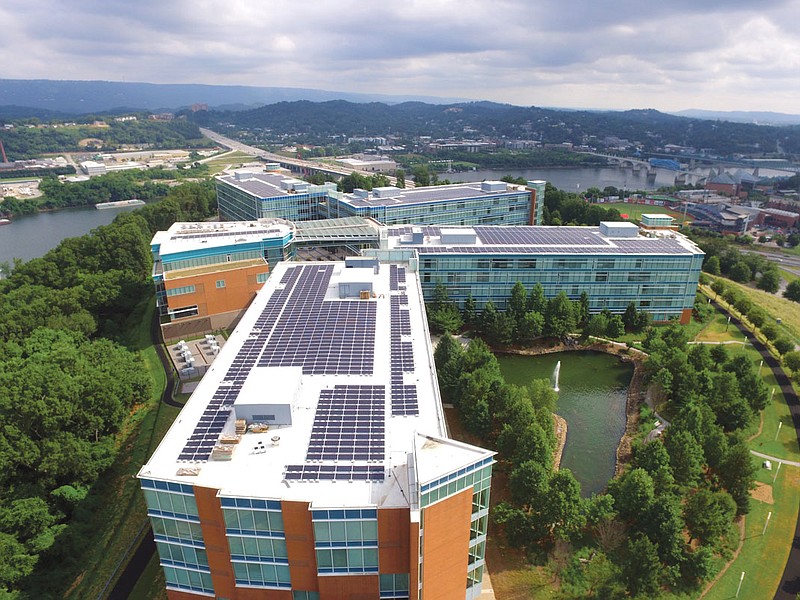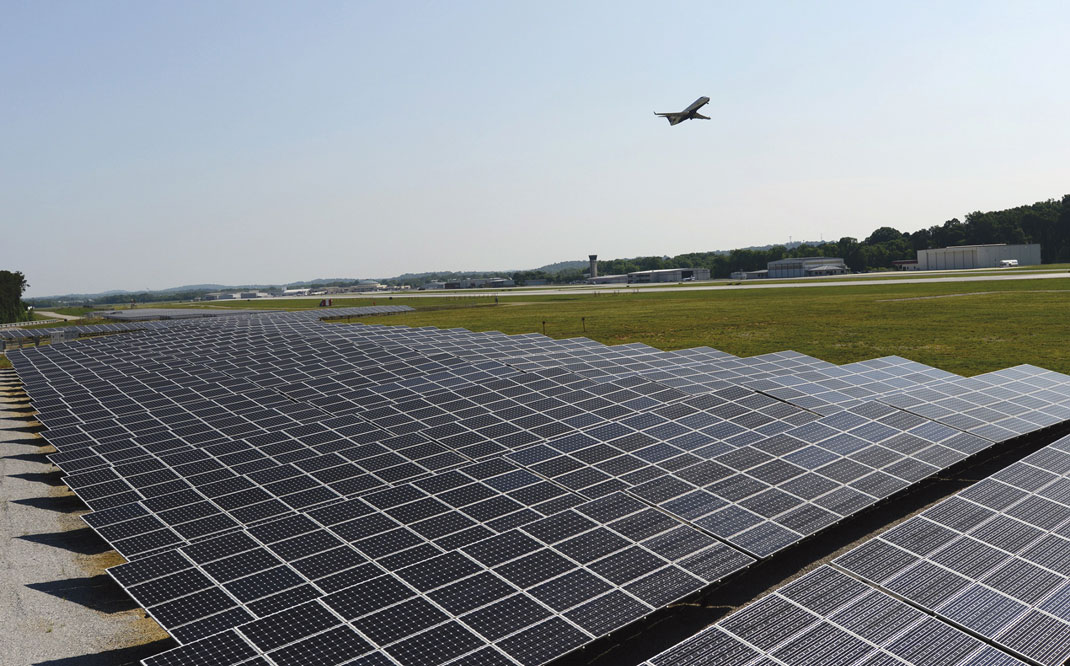August in Chattanooga means soaring temperatures, melting ice cream and an ever present sun. It's natural to long for days when the sun's glare is a welcome treat warming up icy hands in frigid December air.
These days, the sun isn't something to avoid from under a shade tree or lift our faces to in winter. It's part of Chattanooga's sustainability efforts.
BlueCross BlueShield of Tennessee, EPB, Volkswagen Chattanooga (VW) and the Chattanooga Airport lead the solar charge to creating a greener business community.
"At BlueCross, we have a long-term focus on environmental sustainability," says Jeff Sundean, BlueCross Vice President of Properties and Corporate Services. "We believe it's right and a smart thing to invest in."
While building its Cameron Hill corporate office in 2009, BlueCross became the second largest Gold LEED-certified campus in the U.S., setting the stage for continued commitment to sustainability.
In March, BlueCross announced plans to construct 10,000 solar panels on five of their corporate office buildings, on top of their Cameron Hill parking garage and in the parking lot surrounding the Gateway building at the foot of the hill. The solar project is an expansion of smaller solar canopy projects, including an installation originally located on the Gateway building's roof and one currently supporting a regional office in Memphis, Tennessee.
"We are building on what other companies have done in the region and trying to reduce our overall consumption and demand on the energy system," Sundean says.
BlueCross is expanding their solar project in three phases. Phase one adds to existing solar panels at their Gateway facility and is scheduled to start producing energy this month. Phase two is currently under construction and consists of five solar arrays covering five of BlueCross's main office buildings. The final phase is comprised of a large array of solar panels covering the roof of the company's Cameron Hill parking garage, giving employees additional covered parking. Together, they'll generate 4.3 megawatts of electric energy.
"Once all of the solar panels are online we are looking at offsetting an average of 25% of utility power and on peak production days contributing back to the energy grid," Sundean says. "Over the projected useful life of the solar installation, this investment will help us lower operating costs – savings that will enable us to deliver better value for BlueCross members over time."
BlueCross isn't alone in the addition of solar energy as a way of offsetting utility costs. The Chattanooga Airport recently announced completion of the final phase of its solar farm project. The Chattanooga Airport generates 2.64 megawatts of energy, equal to the airport's total energy needs. That's right, the Chattanooga Airport's solar farm generates enough power to equal the airport's total energy needs. This accomplishment makes the Chattanooga Airport the only airport in the U.S. to achieve this sustainable energy goal.
"This project has immediate benefits to our airport and community, and we're proud to set an example in renewable energy for other airports, businesses and our region. While generating a local renewable resource, we are also increasing the economic efficiency of the airport," says Terry Hart, President and CEO of the Chattanooga Airport.
The Chattanooga Airport completed its solar project in three phases with funds from FAA grants. Phase one added 3,948 solar panels generating 255 watts per panel. Phase two created an additional 3,524 panels that generate 310 watts per panel and phase three added the remaining solar panels needed to generate power equal to the airport's total energy needs.
Flying into the Chattanooga Airport, passengers can spot the solar field close to the runway upon descent. It's likely passengers also glimpsed another solar field as they approached Chattanooga.
Manufacturing plants make continual progress in reframing a reputation of not being mindful of the environment. After locating to Chattanooga in 2008, Volkswagen Chattanooga (VW) became the first auto plant in the world to receive Platinum LEED certification in 2011. VW's dedication to sustainability continued and in 2013 the auto-manufacturer installed a 33-acre solar farm on 65 acres of land. It's a 9.5 megawatt system designed to produce 13 gigawatt hours of electricity per year. The energy produced by the 33,600 modules provides up to 12.5% of the electric power required in full-capacity operation and 100% of demand when the plant is not in production.
VW's solar park is a key element of the Volkswagen Group's strategic sustainability targets. The solar farm allows VW to sustainably cut utility costs and airborne emissions by using less coal-powered energy alternatives.
These solar initiatives at BlueCross, the Chattanooga Airport and VW are possible through local partnerships. Currently, BlueCross and the Chattanooga Airport participate in TVA's Generation Partners program which buys solar and other kinds of distributed power generation and then distributes it through local power distributors like EPB. VW partners with Silicon Ranch out of Nashville.
"Business partnerships are critical," Sundean says. "We aren't an island unto ourselves and we take great pride in partnering with local friends and neighbors here in Chattanooga."
As an easy option for participating in locally generated renewable energy, EPB offers Solar Share, Chattanooga area's only community solar deployment.
EPB's Solar Share program gives local companies an easy and affordable option to go green. Solar Share is affordable because the cost is shared among participants. The 3.8 acre solar farm offers 4,408 solar panels that provide the energy for Solar Share.
Since Solar Share's launch, EPB has generated 3.83 gigawatt hours of energy, saving 2,875 tons of coal. The carbon dioxide offset is equal to 69,083 trees planted and the energy generated is equal to 6.46 million miles driven in a car.
"As a whole the number of solar initiatives speaks to our community's environmental way of doing things," Sundean says. "It's that long-term strategic thinking that comes into play and it really is the bigger long-term solar picture."
Our businesses lead the way toward creating a more sustainable future for our community. Instead of dreading the inevitable heatwave of this month, consider the positive impact of the sun's rays on our community-wide sustainability efforts as you duck behind a shade tree to keep your ice cream from melting.

